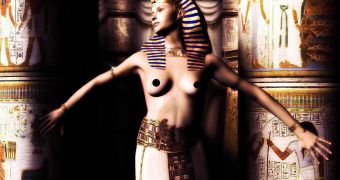Perhaps the most fascinating woman of the ancient Egypt was not Cleopatra (which was not even Egyptian, but Greek), but the female Pharaoh Hatshepsut. Now, the rush for finding her mummy seems to have finally reached an end. This would be the most significant finding from the ancient Egypt since the discovery of the tomb of Tutankhamun by the English archaeologist Howard Carter in 1922.
A broken tooth represents the latest clue which made archaeologists explore the possibility of them having indeed discovered Hatshepsut. In 1903, Carter had encountered two sarcophogi in a tomb marked as KV60 in the Theban necropolis, the Valley of the Kings in Luxor. One apparently harbored the mummy of Hatshepsut's wet nurse Sitre-In and the other's mummy identity remained unknown. When in 1920 he found the tomb of Queen Hatshepsut, the two sarcophagi inside were empty.
The team led by Egypt's secretary general of the country's Supreme Council of Antiquities, Zahi Hawass, used CT scans to get detailed 3D images and connect distinct physical traits of one of the mummies to that of her ancestors.
The box containing the tooth had written on Hatshesupt's name and the box scanning revealed that the tooth "matched within a fraction of a millimeter the space of the missing molar in the mouth of the mummy. The discovery of the Hatshepsut mummy is one of the most important finds in the history of Egypt. Our hope is that this mummy will help shed light on this mystery and on the mysterious nature of her death." said Hawass.
American Egyptologist Elizabeth Thomas is the first to have suspected years ago that the second mummy could be of Hatshepsut, based on the hand resting on her chest, a royal pose. DNA testing on the 3,000 year-old mummy will assess its identity, at the new DNA testing facility of the Cairo Museum.
Still, some Egyptologists, like Salima Ikram, a professor of archeology at the American University in Cairo, do not think that the analysis could be conclusive.
Hatshepsut, daughter of Pharaoh Tuthmosis I - who ruled from 1504-1484 BC - was perhaps the most powerful female monarch of the ancient world. Following the death of her husband-brother Tuthmosis II, she ruled as regent for his son by a concubine, Tuthmosis III. But soon after, Hatshepsut proclaimed herself as pharaoh, wearing royal headdress and a false beard. When she died, her monuments and tomb were destroyed by her jealous successor Tuthmosis III, so that researchers thought for a long time that her mummy was lost.

 14 DAY TRIAL //
14 DAY TRIAL //